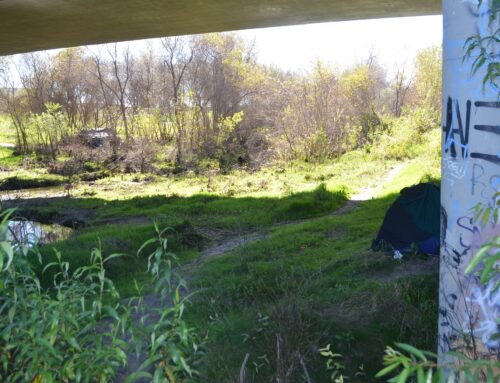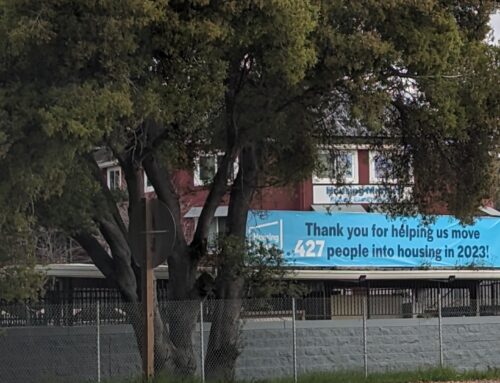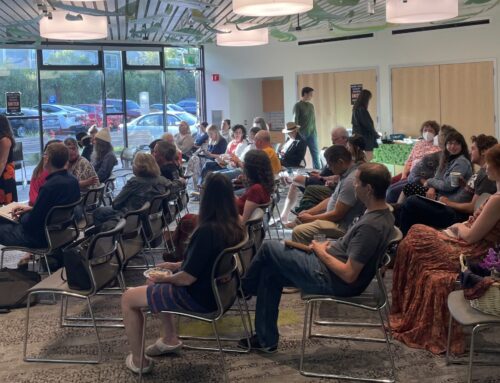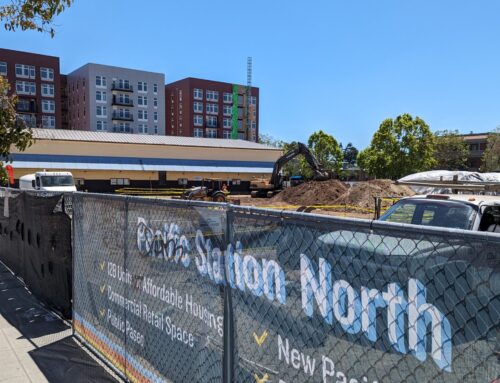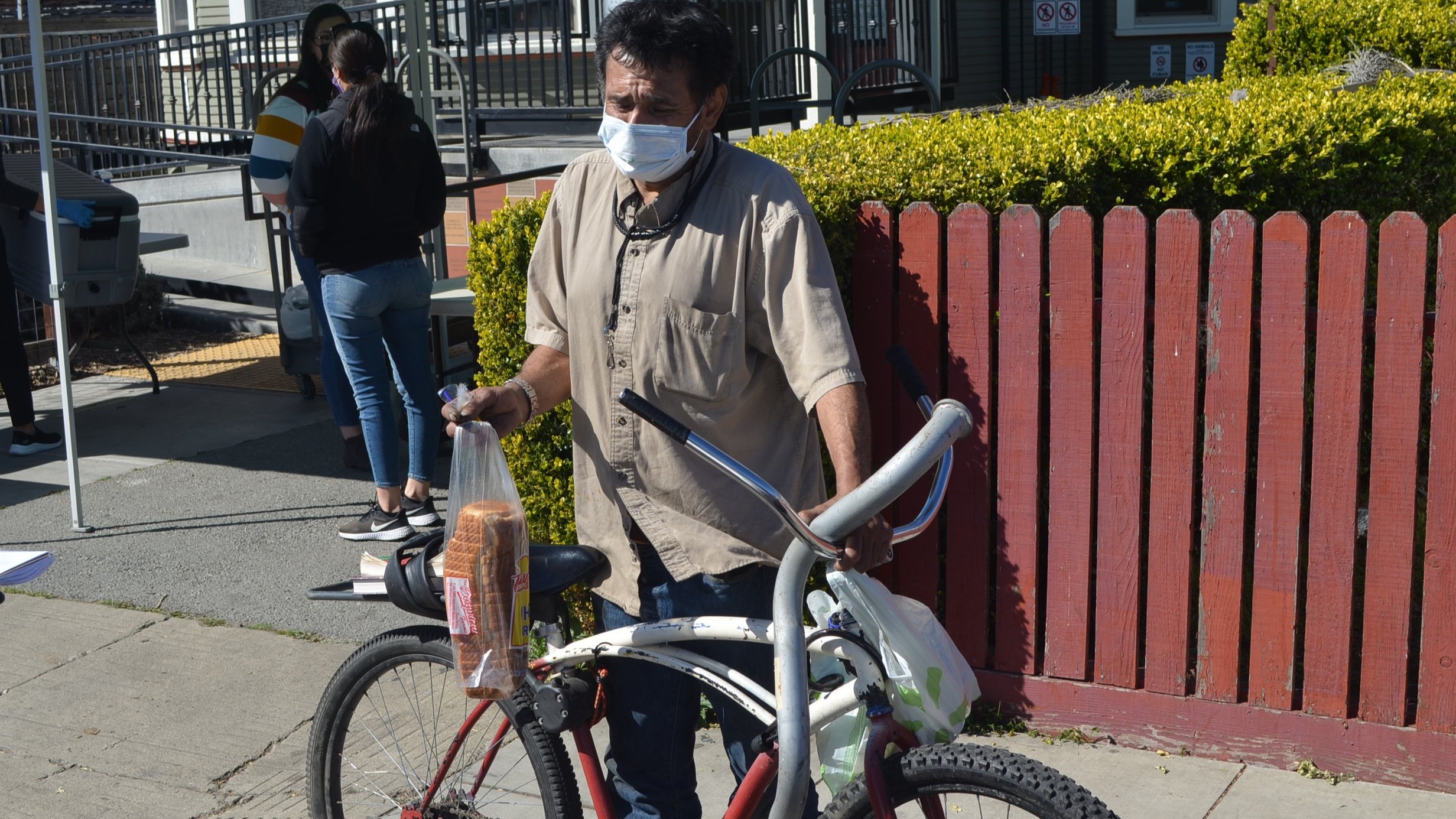
Andres Sandoval, 56, has worked as a plumber. He lived in his vehicle in Watsonville in early 2022 and wanted a more stable situation. (Stephen Baxter — Santa Cruz Local file)
Editor’s note: This is the second story in a three-part series on homeless services spending in Santa Cruz County. Read part one, part three and how this series was made.
SANTA CRUZ >> As leaders in Santa Cruz County try to address homelessness, their efforts lack transparency and are hindered by a rigid and disjointed system of state and federal grants, a Santa Cruz Local investigation has found.
Although local governments report many aspects of homeless services spending and outcomes to the state, leaders in Santa Cruz County have not painted a clear, comprehensive picture of how public dollars are spent on services.
Part one of Santa Cruz Local’s series on homeless services spending uncovered how $126 million in government money was spent on homeless services in Santa Cruz County from 2019 to 2021. It is the first time public spending data has been presented in that way.
Part two explores the money system and its constraints and problems.
Problem 1: A lack of transparency and metrics
Public spending on homeless services in Santa Cruz County is essentially a top-down system that starts with a group called a Continuum of Care that tries to prioritize programs and spending.
Each California county is part of a Continuum of Care that coordinates a regional system of services for people who are homeless or at risk of homelessness. Stakeholders in homeless services, elected leaders and their staff are often included in the group.
Each Continuum of Care:
- Develops and supports a system of housing and service programs.
- Operates the Homeless Management Information System, an internal database of service recipients and other information.
- Designs plans to apply for state money and ways to spend it.
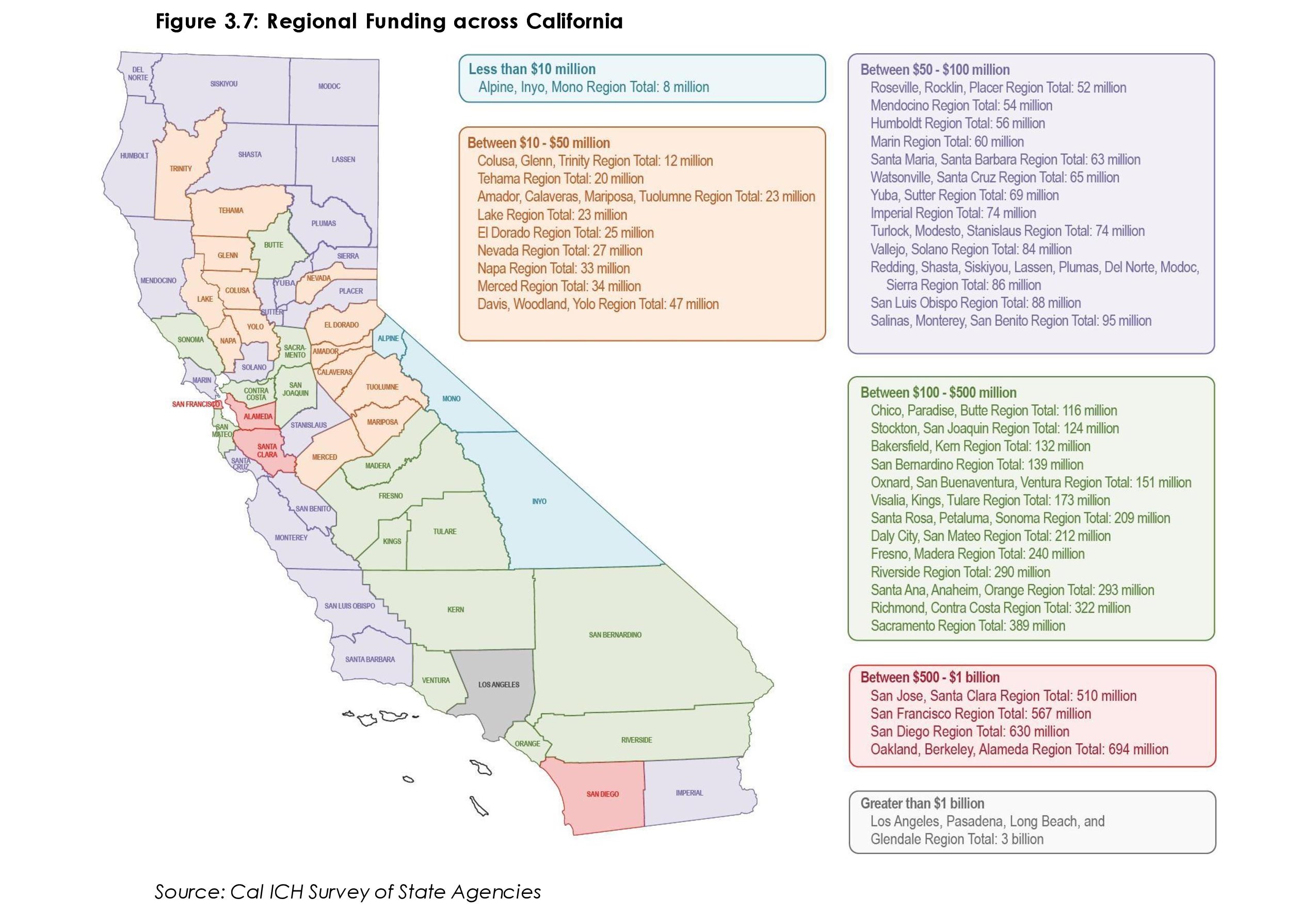
A 2023 map shows Continuums of Care in California and annual funding estimates from fiscal years 2018 to 2021. (California Interagency Council on Homelessness)
With those priorities expressed, county and city staff apply for competitive and restrictive state grants.
- At least $21.4 million was spent on homeless services in Santa Cruz County in fiscal year 2019-2020, according to public records obtained by Santa Cruz Local.
- At least $77.5 million was spent on homeless services in the county in fiscal year 2020-2021, records state.
Some of the money crossed fiscal years or had to be spent by a certain time. Most of it was for specific services, such as for youth or for emergency shelter or “coordinated entry” such as maintaining the Homeless Management Information System. Other grant money was spent on office supplies (at least $1.53 million in fiscal year 2020-21) or “communications” for public relations staff to publicize homeless services spending and progress (at least $398,000 in fiscal year 2020-21).
Most of that money was managed by the County of Santa Cruz. One reason the spending is not transparent is that the county’s accounting system does not separate homeless services spending from other expenditures.
There is no single code for homeless services in the county’s auditing system, and the services span county departments and divisions.
“I think that absent that, you end up with not a very clear picture of how the money is spent,” said Rayne Perez, the County of Santa Cruz’s homeless services coordinator from January 2016 to August 2021.
“I had hoped that over time there would be a way to streamline the county’s budget system so that there could be a way to just roll all that up once easily. But there really is not,” Perez said in a recent interview. “The public has a right to know how the money is spent.”
Broad homeless-services outcomes are similarly opaque in Santa Cruz County.
Each state grant typically requires periodic written updates back to the state about how and when money was spent and its outcomes. Outcomes could include how many people spent a night in a shelter or how many families remained housed because their back rent was covered by rental assistance. But those outcomes for specific contracts are not compiled and made public.
Without those metrics, it’s not clear whether, how or why unhoused people are becoming housed or which services are more effective than others in Santa Cruz County.
“If you can’t even track the expenditures in a systemic way, I think it would be hard to track outcomes in a systemic way,” Perez said. “I think that the county would be very hard pressed to demonstrate outcomes. Because without the proper tracking systems, you can’t,” Perez said.
When Santa Cruz County supervisors adopted a three-year plan to address homelessness, adopted in March 2021, the project was supposed to include a public, online dashboard to track metrics that address homelessness. That dashboard is not yet online.
County leaders have provided six-month updates on the plan’s execution at county supervisors’ meetings.
Larry Imwalle, the City of Santa Cruz’s homelessness response manager, said in February that city staff were working on improved ways to track homeless services spending.
“That first step is building out a comprehensive homeless services budget for the city that spans every department. And that gives us the tools to begin to track specific areas so that we can start to look at it in these ways and compare over time,” Imwalle said. “Understanding where the resources are being spent — towards what purposes towards what outcomes, that’s about data driven decision making. And so it’s an important tool,” Imwalle said.
Problem 2: The tension of short- and long-term goals
When leaders try to deal with homelessness, there is often a tension of what to spend on people’s immediate needs — like hygiene, food, rehabilitation and temporary shelter — and what to spend on longer-term solutions that get people into homes.
Some examples of longer-term solutions include rental assistance through vouchers, case managers, housing navigators and building new permanent supportive housing for people with disabilities.
There is a “tension of whether to respond to emergencies, or plan and invest long-term so that people stop becoming homeless and stay housed,” said Randy Morris, director of Santa Cruz County’s Human Services Department, in a county supervisors meeting this year. “That tension will keep going, and our job as staff is to share those tradeoffs.”
Also, leaders often focus policies on large, unmanaged homeless camps that only represent a small fraction of homeless people in the county, Morris has said.
“Too often, there are very reactionary and myopic solutions put forward that don’t take into account the full scope of the puzzle that needs to be put together. This issue isn’t going to be solved by just identifying a parcel, just identifying better outreach, just identifying one-time money and too much of the work that we’ve been doing has just been based on that,” Morris said in an August 2021 supervisors meeting.
Morris said he hoped the county’s three-year plan to address homelessness would address the deeper issues.
Touch this Santa Cruz Local chart to learn how Santa Cruz County’s Continuum of Care and the County of Santa Cruz spent at least $21.46 million on homeless services in fiscal year 2019-2020 and at least $77.58 million in fiscal year 2020-2021, according to public records and Santa Cruz Local reporting. Read more about category definitions, data limitations and money sources. (Kaitlyn Bartley — Santa Cruz Local)
In their goals, some leaders of the Continuum of Care from 2019 to 2021 tried to manage those competing interests but didn’t have the skill set.
Leaders were often politicians or their staff who were too removed from unhoused people and homeless services to make consistently sound spending preferences, said Brooke Newman, the homelessness response manager in the City of Santa Cruz for part of 2020.
“Like, oh, we’re gonna take people out of a (managed) camp and put them in a hotel room, that’s definitely a step up. Yes. And you’re once again destabilizing a person,” Newman said. “Even though they have a solid roof over their head and a bathroom, it’s another way to destabilize someone and the outcomes may not end up good.”
Newman was also the project manager of Santa Cruz’s Downtown Streets Team and later worked for Santa Cruz County’s Continuum of Care.
Newman said a big problem in 2020 and 2021 was a lack of case managers and housing navigators to get people into permanent housing. Shelters lacked these roles, and many well-meaning but inexperienced staff in shelters and other services did not have the training to help people find permanent homes. Many of those service providers burned out and left the field.
Another problem was that nonprofit service providers lacked coordination of services, Newman said. A “skilled facilitator” remains needed to coordinate services providers and work toward a shared goal, she said.
Touch this Santa Cruz Local chart shows to learn how more than $126 million of local, state and federal government money spent on homelessness in Santa Cruz County from 2019 to 2021. Read more about category definitions, data limitations and money sources. (Kaitlyn Bartley — Santa Cruz Local)
Problem 3: Grant money drives services, not goals
Because county and city leaders mainly rely on state grants for specific services related to homelessness, county supervisors and city councils can express priorities for specific services — but the money might not materialize and it might not be renewed after a year or two regardless of whether anyone was housed or served appropriately.
“In an ideal world, it would be the other way around. We would design what we want to do, and then we would apply for those funds to do specifically what we want to do. But that’s not typically how funding is made available,” Perez said. “The fact that we chase the money that’s made available means we do what the money is made available to do,” Perez said.
Perez said she applied for every state grant that she could find that was related to homeless services — regardless of the specific goals of county leaders or the Continuum of Care.
“In my role, I applied for everything,” Perez said. “When you have nothing, and you have an opportunity to apply for something, you go after it. I think it’s irresponsible for a community to have a profound homelessness problem and not go out after every homeless dollar that they could bring in,” Perez said.
A big shift in 2020 was the availability of millions of new dollars from the state and federal governments to address homelessness with grants related to the COVID-19 pandemic.
From 2019 to 2021, the Continuum of Care board “prioritized shelter because we had such a huge unsheltered population,” Perez said. “We went from having a very limited winter shelter program that was only open for a few months of the year, and only overnight, to having several year-round shelters, some of which were 24 hours. And a lot more people were protected and were able to access services.”
Some of the many groups that received money and contract work during that time included:
- Salvation Army.
- Housing Matters.
- Community Action Board.
- Encompass.
- Association of Faith Communities.
Some COVID-related funding sources:
- Project Roomkey was a California state program aimed at providing hotel rooms for homeless people considered high risk for medical complications from COVID-19. From April 2020 to June 2022, the program paired more than 700 homeless residents with hotel rooms in Santa Cruz County.
- California COVID-19 Rent Relief Program: This state program was the largest source of rent assistance for Santa Cruz County residents during the pandemic, but not until fiscal year 2021-2022. From March 15, 2021 to June 30, 2021, Santa Cruz County residents received $381,563 from the program, reflected in the Santa Cruz Local chart above. More than $28.5 million was paid to 2,409 Santa Cruz County households with average assistance of about $11,400 as of May 2, 2023, according to a state dashboard. Many leaders in Santa Cruz County criticized the program’s long wait times to review applications and deliver money.
- The Coronavirus Aid, Relief, and Economic Security (CARES) Act: This federal act awarded $4 billion to local jurisdictions through the Emergency Solutions Grants Program in 2020 to help prevent homelessness during the pandemic. Santa Cruz County received $9,950,258, according to public records. The county spent $360,751 in fiscal year 2020-21.
Problem 4: A ‘maze’ of bureaucracy
Dr. Robert Ratner was hired as director of Santa Cruz County’s Housing for Health Department in late 2020. A physician who previously worked in homeless services in Alameda County, Ratner is in charge of homeless services in the county.
During a county supervisors meeting this year, Ratner described a “maze” of state grant applications, rules, contracts and reporting deadlines that hinder efficiency.
“We spend a lot of our time, as staff, navigating and braiding this funding together to get outcomes. It’s a lot of wasted taxpayer dollars, to be honest with you,” Ratner said during the February meeting.
“The amount of time I spend, the amount of time my coworkers spend in all of this work — we’d rather be helping people move into housing,” Ratner said. “To the extent that the state and federal government can make it easier and consistent with the funding that we receive and be more predictable, we can have a much bigger impact on our community,” he said.
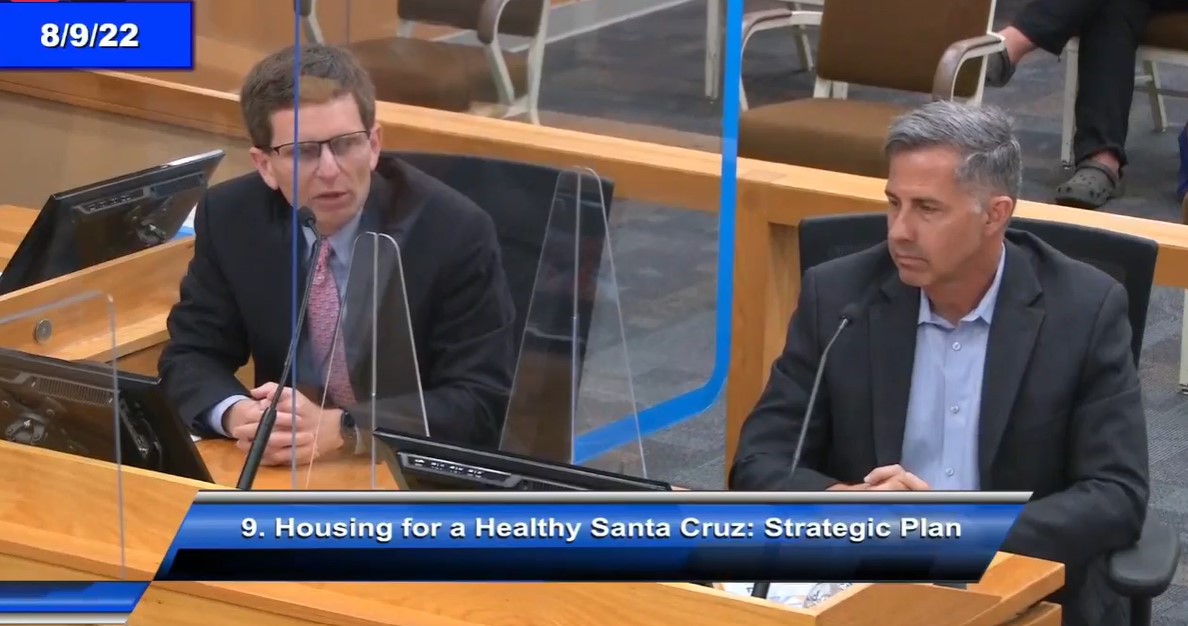
Santa Cruz County Housing for Health Director Robert Ratner, left, discusses homeless services during a Santa Cruz County Supervisors meeting on Aug. 9, 2022. Santa Cruz County Human Services Department Randy Morris is seated next to him. (County of Santa Cruz screenshot)
Grants typically specify how the money can be spent on when it must be spent. If state grant money is secured, county leaders often issue a request for proposals to nonprofit groups or other contractors to carry out the work. County staff then has to review the proposals, select one, negotiate a contract and possibly get county supervisors’ approval in a scheduled supervisors meeting.
“Once we get something under contract, if we then only have six months or a year or 18 months to get the money spent, that can be a real problem,” Perez said.
“Every single funding stream has different requirements. And I can say that as the person who is sitting in the seat of trying to disentangle all of that and figure out what money we can spend on which activities, it’s a very complicated job and extremely difficult,” Perez said.
“Often it required braiding different sources of funds together to accomplish a specific thing,” she said.
City of Santa Cruz money
Many of Santa Cruz County’s unhoused people live in the City of Santa Cruz, but the city has far less access to money for homeless services.
Santa Cruz city leaders spent about $5.32 million on homeless services from July 2019 through June 2021. Temporary shelters and rental assistance were the top two spending categories, according to public records.
Funding sources included:
- The city’s General Fund, which is supported by local tax dollars.
- The federal Community Development Block Grant Program.
- The federal HOME Investments Partnership Program.
- The city’s Red Cross Housing Reconstruction Loan Repayment Fund.
- Money created by the McKinney-Vento Homeless Assistance Act, a federal law.
A 2019 city staff estimate of homelessness spending outlined about $16.2 million worth of city staff time on police response to homelessness-related calls, campsite cleanup, open space management and law enforcement. Santa Cruz Local’s estimates did not include these staff expenses because the staff would have been paid regardless of their homeless-related duties.
Touch this Santa Cruz Local chart to show how state, federal and local money for homelessness was spent in fiscal years 2019-20 and 2020-21 in the City of Santa Cruz. Read more about category definitions, data limitations and money sources. (Kaitlyn Bartley — Santa Cruz Local)
“On an issue like homelessness that is pervasive and driven by systemic factors, it really requires collaboration at all levels of government — city, county, that regional collaboration, most importantly — but also the state and federal government,” said Imwalle, Santa Cruz’s homeless response manager.
Imwalle was hired in October 2021. He said Santa Cruz’s spending mix from 2019 to 2021 seemed appropriate. “I think it’s consistent with this movement and growth and the city’s role in this space.”
In March 2022, Santa Cruz city leaders adopted a Homelessness Response Action Plan.
It aimed to:
- Provide shelter, hygiene and storage services. Leaders want to eliminate unsanctioned homeless camps and move people to managed shelters in the city and throughout the county.
- Build capacity and partnerships to improve the city staff’s coordination of services. Leaders want to expand mental health and addiction treatment, outreach, shelter and job training for homeless people. They also pledged to prioritize environmental restoration and protection.
- Address RV parking and law enforcement. The plan calls for equitable law enforcement and an updated model for deployment of police to calls related to homelessness.
- Expand affordable housing and supportive housing.
In 2022, the city received $14.5 million in one-time money from the state legislature to address homelessness. It is expected to be spent by July 2023, city leaders have said.
“That funding is flexible, and I think that’s extremely helpful in doing this work in general to have the flexibility to adjust and spend locally with a local plan,” Imwalle said. “Oftentimes a lot of funding is very prescriptive.”
Watsonville homeless service spending
In Watsonville, at least $2.92 million was spent on homeless services during the 2019-2020 fiscal year, followed by at least $7.51 million in spending during the 2020-2021 fiscal year.
A Santa Cruz Local chart shows how state, federal and local money for homelessness was spent in fiscal years 2019-20 and 2020-21 in Watsonville. Read more about category definitions, data limitations and money sources. (Kaitlyn Bartley — Santa Cruz Local)
Watsonville’s largest spending categories were in permanent housing development and rental assistance.
“Our focus has been on providing, building and maintaining affordable, permanent housing — and also to help people stay housed,” said Carlos Landaverry, Watsonville’s housing manager.
“The way it works for us is really tied to the funding source,” Landaverry said. “There is money that we can use to support the rental housing and there is money that we can use to support housing programs, get people into housing, first-time homebuyer programs, things like that. And then during the pandemic, we got money that was geared specifically for rental assistance,” Landaverry said.
Funding sources included:
- The city’s General Fund, which is supported by local tax dollars.
- The federal Community Development Block Grant Program.
- The federal HOME Investments Partnership Program.
- A $2.3 million city loan in 2020 to housing developer MidPen for a 72-unit affordable housing project on Miles Lane.
Ryan Hoffman, an unhoused 43-year-old former social worker, said Watsonville’s approach seemed appropriate.
“If you’re just looking at the numbers alone and where their money’s going, [Watsonville] obviously has a more direct approach to actually solving this problem of homelessness,” Hoffman said.
“We understand that they have a large problem on their hands,” Hoffman said. “We also need to be part of the solution of that problem and not just be ostracized from our community and made it seem like we don’t exist or we’re not part of that community. Because we absolutely are.”
Read more in this series
- Part 1: From shelters to rent help, 14 categories of homeless services spending in Santa Cruz County traced from 2019 to 2021
- Part 3: Effective homeless services spending and a need for housing in Santa Cruz County
- Glossary of homeless services spending categories and money sources
- Editor’s note on how and why this series was made
Learn more
- Santa Cruz Local’s Solutions to Homelessness series
- Podcast: How Santa Cruz County could solve chronic homelessness — Dec. 17, 2021
- Homelessness survey reveals some common ground in Santa Cruz County — Oct. 8, 2021
- Podcast: Homeless and formerly homeless residents discuss solutions in Santa Cruz County — Nov. 19, 2021
- Strides and stalls in Santa Cruz County homeless plan — Feb. 28, 2023
- Shared data, goals in Santa Cruz County’s plan for homeless — March 10, 2021
Questions or comments? Email [email protected]. Santa Cruz Local is supported by members, major donors, sponsors and grants for the general support of our newsroom. Our news judgments are made independently and not on the basis of donor support. Learn more about Santa Cruz Local and how we are funded.
Stephen Baxter is a co-founder and editor of Santa Cruz Local. He covers Santa Cruz County government.


